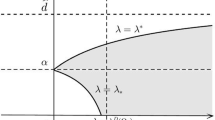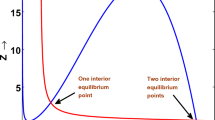Abstract
This paper considers a plankton–fish interaction model by comparing the dynamics between non-spatial and spatial systems. In the model, both the fish and phytoplankton populations are assumed to be growing logistically, the fish population is nonlinearly harvested, and the interaction between phytoplankton and zooplankton is described by the Crowley–Martin functional response. Stability analyses for the plankton–fish interaction model have been carried out for both non-spatial and spatial systems. The theoretical results are then supported by numerical simulations. In the case of non-spatial system, single-parameter bifurcation diagrams are used, while in the spatial system numerical simulations for one- and two-dimensional cases are performed. In the case of a non-spatial system, the conditions for the existence of a positive equilibrium point, as well as their local and global stability analyses, have been obtained. In the spatial system, the stability and existence of Hopf bifurcation have been discussed, and different conditions for Turing pattern information have been established through diffusion-driven instability analysis. Taken together, these results show that spatial heterogeneity, the mortality rate of phytoplankton, and the constant harvesting of the fish population play important roles in the dynamical behavior of the marine system.









Similar content being viewed by others
References
Baek, H., Jung, D.I., Wang, Z.W.: Pattern formation in a semi-ratio-dependent predator–prey system with diffusion. Discret. Dyn. Nat. Soc. 2013, 1–14 (2013)
Belkhodja, K., Moussaoui, A., Alaoui, M.A.: Optimal harvesting and stability for a prey–predator model. Nonlinear Anal. Real World Appl. 39, 321–336 (2018)
Berryman, A.A.: The origin and evolution of predator–prey theory. Ecology 73(5), 1530–1535 (1992)
Crowley, P.H., Martin, E.K.: Functional responses and interference within and between year classes of a dragonfly population. J. North Am. Benthol. Soc. 8(3), 211–221 (1989)
Chow, S.N., Hale, J.K.: Methods of Bifurcation Theory, vol. 251. Springer, Berlin (2012)
Clark, C.W.: Mathematical Boieconomics: The Optimal Management of Renewable Resources. Wiley, New York (1976)
Das, A., Pal, M.: Theoretical analysis of an imprecise prey-predator model with harvesting and optimal control. J. Optim. 2019, 1–12 (2019)
Dubey, B., Agarwal, S., Kumar, A.: Optimal harvesting policy of a prey–predator model with Crowley–Martin-type functional response and stage structure in the predator. Nonlinear Anal. Modell. Control 23(4), 493–514 (2018)
Han, X., Bi, Q., Zhang, C., Yu, Y.: Study of mixed-mode oscillations in a parametrically excited van der Pol system. Nonlinear Dyn. 77(4), 1285–1296 (2014)
Han, X., Xia, F., Zhang, C., Yu, Y.: Origin of mixed-mode oscillations through speed escape of attractors in a Rayleigh equation with multiple-frequency excitations. Nonlinear Dyn. 88(4), 2693–2703 (2017)
Han, X., Bi, Q., Ji, P., Kurths, J.: Fast-slow analysis for parametrically and externally excited systems with two slow rationally related excitation frequencies. Phys. Rev. E 92(1), 012911 (2015)
Kar, T.K., Chaudhuri, K.S.: Harvesting in a two-prey one-predator fishery: a bioeconomic model. ANZIAM J. 45(3), 443–456 (2004)
Meng, X.Y., Wu, Y.Q.: Bifurcation and control in a singular phytoplankton–zooplankton–fish model with nonlinear fish harvesting and taxation. Int. J. Bifurc. Chaos 28(03), 1850042 (2018)
Medvinsky, A.B., Petrovskii, S.V., Tikhonova, I.A., Malchow, H., Li, B.L.: Spatiotemporal complexity of plankton and fish dynamics. SIAM Rev. 44, 311–370 (2002)
Maiti, A.P., Dubey, B.: Stability and bifurcation of a fishery model with Crowley–Martin functional response. Int. J. Bifurc. Chaos 27(11), 1750174 (2017)
Pontryagin, L.S., Boltyanskii, V., Gamkrelidze, R., Mischchenko, E.F.: The Mathematical Theory of Optimal Process. Inter-Science, New York (1962)
Pascual, M., Caswell, H.: Environmental heterogeneity and biological pattern in a chaotic predator–prey system. J. Theoret. Biol. 185(1), 1–13 (1997)
Pascual, M.: Diffusion-induced chaos in a spatial predator–prey system. Proc. R. Soc. Lond. Ser. B Biol. Sci. 251(1330), 1–7 (1993)
Panja, P., Mondal, S.K., Jana, D.K.: Effects of toxicants on phytoplankton–zooplankton–fish dynamics and harvesting. Chaos Solitons Fract. 104, 389–399 (2017)
Raw, S.N., Mishra, P.: Modeling and analysis of inhibitory effect in plankton–fish model: application to the hypertrophic Swarzedzkie Lake in Western Poland. Nonlinear Anal. Real World Appl. 46, 465–492 (2019)
Ren, J., Yu, L., Siegmund, S.: Bifurcations and chaos in a discrete predator–prey model with Crowley–Martin functional response. Nonlinear Dyn. 90(1), 19–41 (2017)
Ryu, K., Ko, W., Haque, M.: Bifurcation analysis in a predator-prey system with a functional response increasing in both predator and prey densities. Nonlinear Dyn. 94(3), 1639–1656 (2018)
Sandri, M.: Numerical calculation of Lyapunov exponents. Math. J. 6(3), 78–84 (1996)
Shi, X., Zhou, X., Song, X.: Analysis of a stage-structured predator–prey model with Crowley–Martin function. J. Appl. Math. Comput. 36(1–2), 459–472 (2011)
Sun, G.Q.: Mathematical modeling of population dynamics with Allee effect. Nonlinear Dyn. 85(1), 1–12 (2016)
Smith, J.: Models in Ecology. Cambridge University Press, Cambridge (1974)
Upadhyay, R.K., Tiwari, S.K., Roy, P.: Complex dynamics of wetland ecosystem with nonlinear harvesting: application to Chilika Lake in Odisha, India. Int. J. Bifurc. Chaos 25(07), 1540016 (2015)
Upadhyay, R.K., Roy, P.: Disease spread and its effect on population dynamics in heterogeneous environment. Int. J. Bifurc. Chaos 26(01), 1650004 (2016)
Upadhyay, R.K., Tiwari, S.K.: Ecological chaos and the choice of optimal harvesting policy. J. Math. Anal. Appl. 448(2), 1533–1559 (2017)
Upadhyay, R.K., Kumari, S., Kumari, S., Rai, V.: Salton Sea: an ecosystem in crisis. Int. J. Biomath. 11(08), 1850114 (2018)
Upadhyay, R.K., Naji, R.K.: Dynamics of a three species food chain model with Crowley–Martin type functional response. Chaos Solitons Fract. 42(3), 1337–1346 (2009)
Upadhyay, R.K., Kumari, S., Kumar, P., Rai, V.: Spatial distribution of microalgae in marine system: a reaction–diffusion. Ecol. Complex. 39(2019), 100771 (2019)
Volpert, V.A.: Elliptic Partial Differential Equations. Birkhäuser, Boston (2011)
Wang, J., Liu, X., Liang, J.: Bogdanov–Takens bifurcation in an oscillator with positive damping and multiple delays. Nonlinear Dyn. 87(1), 255–269 (2017)
Acknowledgements
The authors express their gratitude to the associate editor and the reviewers whose comments and suggestions have helped to improve the manuscript. The authors thank Dr. Vikas Rai for helpful discussion during revision. This work has been supported by the Science & Engineering Research Board (SERB), DST, Govt. of India, under grant No. MTR/2017/000301 to the corresponding author.
Author information
Authors and Affiliations
Corresponding author
Ethics declarations
Conflict of interest
The authors declare that there is no conflict of interests regarding the publication of this article.
Ethical standard
The authors state that this research complies with ethical standards. This research does not involve either human participants or animals.
Additional information
Publisher's Note
Springer Nature remains neutral with regard to jurisdictional claims in published maps and institutional affiliations.
Rights and permissions
About this article
Cite this article
Kumari, S., Upadhyay, R.K. Dynamics comparison between non-spatial and spatial systems of the plankton–fish interaction model. Nonlinear Dyn 99, 2479–2503 (2020). https://doi.org/10.1007/s11071-019-05415-6
Received:
Accepted:
Published:
Issue Date:
DOI: https://doi.org/10.1007/s11071-019-05415-6




